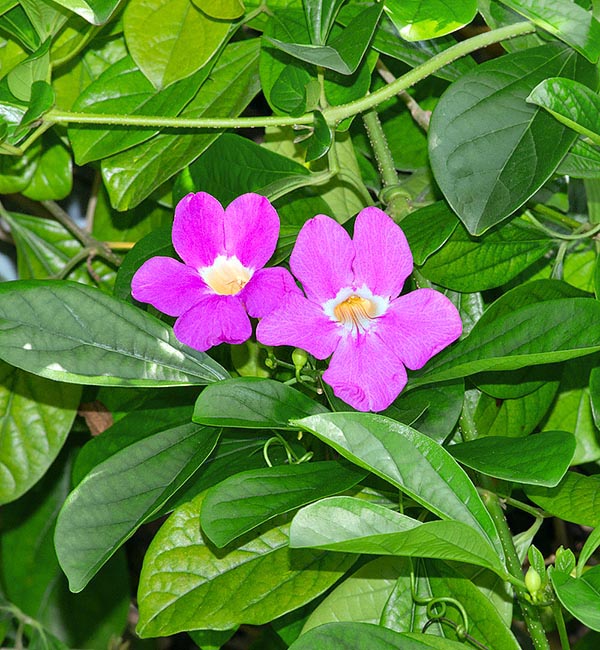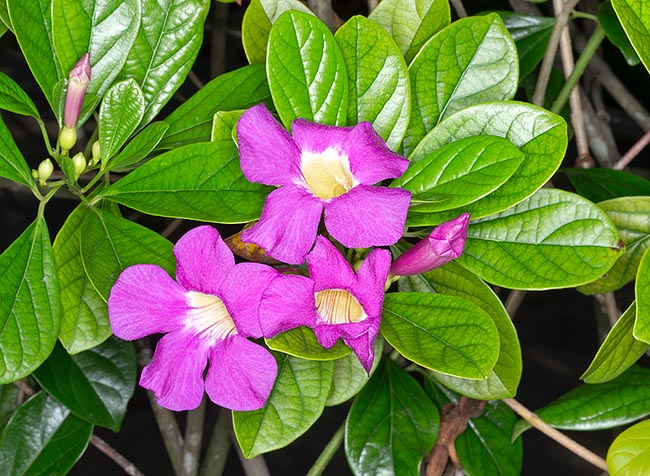Family : Bignoniaceae

Text © Pietro Puccio

English translation by Mario Beltramini

Bignonia magnifica is a woody climber of Central America with even 10 m long stems © Giuseppe Mazza
The species is native to Colombia, Ecuador, Panama and Venezuela where it grows in the humid forests, at the margins of the clearings or climbing on the trees, from the sea level up to about 1000 m of altitude.
The genus is honoured to the member of the French Academy Jean-Paul Bignon (1662-1743); the specific name is the Latin adjective “magnificus, a, um” = magnificent, pompous, with obvious reference.
Common names: glow vine, purple bignonia, purple funnel vine (English); Saritéia (Portuguese-Brazil); campanilla, palo negro (Spanish).
The Bignonia magnifica W.Bull (1879) is an evergreen woody climber, up to 10 m long, or more in favourable conditions, provided with simple, 10-15 cm long, cirri with which it anchors on the supports.
The leaves, on a 1,2-1,5 cm long petiole, are opposite, bi-trifoliate, the terminal is often modified in cirrus or reduced to a scar, with obovate opposite leaflets with obtuse apex and entire margin, 5-11 cm long and 3-6,5 cm broad, coriaceous, of intense green colour, with prominent nervations below.
Panicle axillar or terminal inflorescences bearing 10-15 flowers, of 6-8 cm of diameter, with campanulate calyx usually truncated at the apex, 0,8 cm long, of olive green colour, imbutiform corolla, 8-9 cm long, with 5 roundish lobes, 2-3 cm long and broad, mauve to violet purple, and whitish throat with longitudinal purple veins. The fruits are flattened linear capsules, 15-28 cm long and about 1 cm broad, containing several oblong bialate seeds, 3,5 cm long (wings included) and 0,8 cm broad. It propagates by seed, rarely produced in cultivation out from the origin zone, and easily by cutting in sandy loam in spring-summer or by air layering.

Fast growth and showy blooming, more times per year, in the tropical gardens © Giuseppe Mazza
Requires an exposition in full sun, or even a slight shade, and draining soils rich of organic substance, slightly acidic to slightly alkaline. The waterings, in absence of rains, must be regular, but leaving the soil to partially dry up, and the fertilizations, from spring to autumn, to be done preferably with balanced products with microelements.
It can be cultivated in pot, preferably grown as shrub, in organic loam with addition of sand or agri-perlite per a 30% to improve the draining, for the decoration of greenhouses, verandahs and winter gardens in the less favourable climates, in position as much luminous as possible, with lowest winter temperatures not under the 15 °C, even if it can stand some degree less. Regular and abundant waterings during the vegetative period, avoiding stagnations, more spaced in winter, but without ever allowing the substratum to dry up completely, and monthly fertilizations from spring to autumn with hydrosoluble balanced products, with microelements, at half the dosage suggested on the package.
Synonyms: Arrabidaea magnifica (W.Bull) Sprague ex Steenis (1927); Saritaea magnifica (W.Bull) Dugand (1945).
